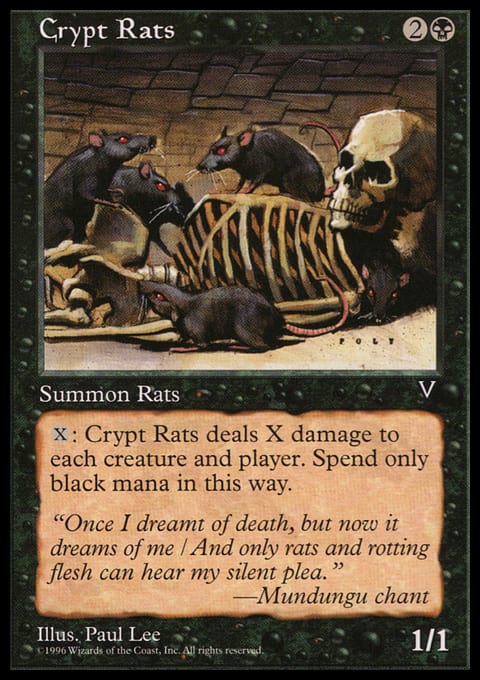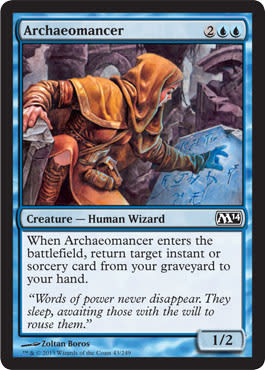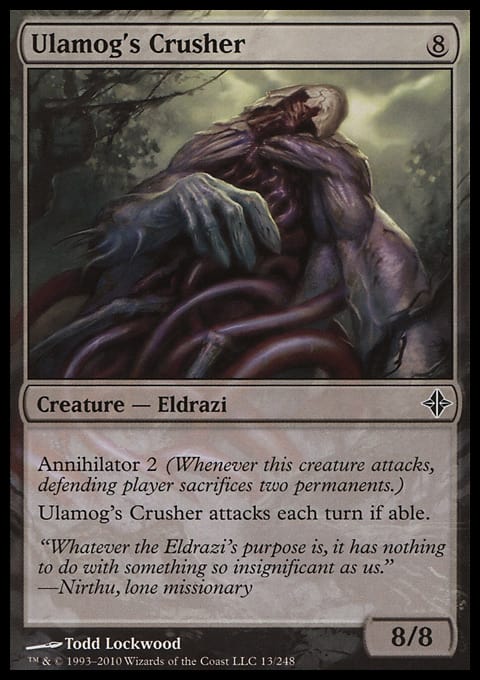Control is a hotly debated topic in Pauper circles. For much of the format’s lifespan many of the decks that adopt a “control” moniker fall in line with the part of the spectrum clearly labeled “Midrange”. As discussed in the first part of this series, Pauper lacks many of the elements that can make control decks strong in other formats. There are no Planeswalkers and few other other persistent forms of card advantage. The board wipes that do exist are narrow and limited in their scope which can make it hard for slower decks to pull even in the midgame against strategies that flood the board. Finally Pauper lacks efficient control finishers.
At the same time Pauper has access to some of the strongest removal available in Magic. Lightning Bolt is one of the best cards ever printed and cards like Journey to Nowhere and Chainer's Edict are powerful in their own right. Pauper has the tools to deal with creatures on a one to one basis. It also has an abundance of “draw 2” effects. The result is that Pauper control decks will often spend the early game trading one-for-one and slowly accruing card advantage with draw spells until they have a clear path to victory.
It is impossible to discuss control in Pauper with talking about Mono-Black Control. Mono-Black, also known as MBC, is a long time staple of the format even though it has not been a top deck since before the Peregrine Drake ban. To this day MBC acts a litmus test of whether or not a creature based deck can succeed in Pauper.
Mono-Black Control ? Pauper | andresfelipehiguera, 5-0 Pauper Leage
- Creatures (17)
- 1 Crypt Rats
- 4 Chittering Rats
- 4 Cuombajj Witches
- 4 Gray Merchant of Asphodel
- 4 Phyrexian Rager
- Instants (9)
- 2 Tendrils of Corruption
- 3 Victim of Night
- 4 Disfigure
- Sorceries (11)
- 2 Corrupt
- 2 Unearth
- 3 Chainer's Edict
- 4 Sign in Blood
- Lands (23)
- 20 Swamp
- 3 Barren Moor
- Sideboard (15)
- 1 Crypt Rats
- 1 Death Denied
- 1 Rancid Earth
- 2 Nausea
- 3 Relic of Progenitus
- 3 Duress
- 4 Choking Sands
Mono-Black Control is a midrange control deck. The core has remained the same — value creatures and removal — but the overarching game plan has changed over time. Originally MBC used Phyrexian Rager and Chittering Rats to accrue advantage and buy time until Corrupt could show up and end games. Crypt Rats and Grim Harvest helped to keep the board clear and the creatures flowing. The earliest versions of this deck helped to define the format with Tendrils of Corruption stealing entire turns off an opponent. As Pauper sped up it evolved into a deck that used these same creatures to get ahead thanks to Unearth. The release of Theros saw the deck shift gears again, this time using the same creature suite to fuel Devotion for Gray Merchant of Asphodel.
Throughout it all Mono-Black Control has had a fairly consistent core. Chittering Rats and Phyrexian Rager are each worth more than a card while Sign in Blood (and sometimes Night's Whisper) puts you up a card. Removal like Chainer's Edict, Disfigure, Victim of Night, and others help to keep the path clear. Whether it wins via Twisted Abomination, Gurmag Angler, Corrupt, or Gray Merchant of Asphodel, MBC needs to stay alive to the end game. The best tool for this job is Chittering Rats.
Chittering Rats is emblematic of midrange control in Pauper. It comes down on turn three and trades with an attacker while also setting your opponent back a draw step. For a long time if Chittering Rats was a card you wanted to play in a given metagame then Mono-Black Control was going to be a good deck. This is no longer the case.
Part of the allure of Mono-Black was its rock solid mana base. Being able to hit spells on the optimal turn is of vital import in Pauper and for many years the best way to accomplish this was to simply run a single color deck. The advent of the Khans of Tarkir Gain Lands have changed this dynamic. The ability to access two colors and get a small boost in life buffer has given slower decks the option to branch into additional colors without the same threat of getting run over. Mono-Black Control, with its slow grind for two-for-ones cannot keep up with decks that can easily splash for Mulldrifter.
Dimir Flicker ? Pauper | tomjab, 5-0 Pauper League
- Creatures (14)
- 2 Archaeomancer
- 4 Chittering Rats
- 4 Mulldrifter
- 4 Sea Gate Oracle
- Instants (14)
- 1 Echoing Decay
- 1 Miscalculation
- 1 Reaping the Graves
- 2 Disfigure
- 2 Ghostly Flicker
- 3 Doom Blade
- 4 Counterspell
- Sorceries (9)
- 1 Unearth
- 4 Chainer's Edict
- 4 Preordain
- Enchantments (1)
- 1 Dead Weight
- Lands (22)
- 5 Swamp
- 6 Island
- 1 Barren Moor
- 1 Lonely Sandbar
- 1 Radiant Fountain
- 4 Dimir Aqueduct
- 4 Dismal Backwater
- Sideboard (15)
- 1 Deep Analysis
- 2 Dispel
- 2 Duress
- 3 Hydroblast
- 2 Nausea
- 2 Relic of Progenitus
- 3 Stormbound Geist
Running Blue and Black, Dimir Flicker has supplanted MBC as the Chittering Rats deck of the moment. A midrange deck with a combo finish, Dimir Flicker has a number of broad answers like Counterspell and Chainer's Edict to defend its game plan of playing value creatures. Eventually the deck will win by looping Ghostly Flicker through Chittering Rats and Archaeomancer on an opponent’s draw step. The loop will potentially stop the opponent from casting any more cards and eventually enough 2/2s will deal 20 points of damage.
The deck is held together with Preordain, Sea Gate Oracle, and Mulldrifter. Dimir Flicker is a fairly robust deck despite running few creatures. The reason is the single copy of Reaping the Graves. Timed correctly, the Scourge Storm spell can get back every creature in the combo while also being the right card type to be recurred with Archaeomancer. Once the lock is in place it can be difficult to disrupt. The deck also constantly advances its game plan by seeing more cards. The amount of draw and filtering available makes it so that the game ending play does not need to cost 5 mana but instead can be assembled from multiple pieces.
While a strong midrange strategy Dimir Flicker is no dominant. It takes time to set up and stopping Ghostly Flicker can render the deck rather anemic. Graveyard removal is prevalent in Pauper and the ability to exile the instant turns Dimir Flicker into a collection of undersized creatures.
Dimir Flicker exists at the intersection of creature based control and spell based control. The former has Chittering Rats as a mascot while Archaeomancer represents the other half. While decks have long made use of Mnemonic Wall and Izzet Chronarch for value it is only in the wake of Peregrine Drake that Archaeomancer based control decks have become a significant portion of the Pauper metagame. The ‘Mancer and Mnemonic Wall both help decks approximate tutors. Pauper decks are very good at casting spells and since decks tend to be packed with redundancies these two creatures can peer through the graveyard for the correct tool for the job. Ghostly Flicker allows these creatures to recur enter the battlefield effects from other creatures. Other decks have opted to pair the Blue creatures with Pulse of Murasa. Pulse allows these decks to set up a strong defense early and bolster their life total late. Pulse of Murasa also acts as another pseudo-tutor. Pulse of Murasa and Archaeomancer help control decks survive the early game and give them the ability to turn the corner late.
Murasa Tron ? Pauper |hiveking, 5-0 Pauper League
- Creatures (10)
- 1 Ulamog's Crusher
- 2 Mnemonic Wall
- 3 Sea Gate Oracle
- 4 Mulldrifter
- Instants (13)
- 1 Capsize
- 1 Dispel
- 1 Magma Spray
- 1 Moment's Peace
- 1 Repeal
- 2 Condescend
- 2 Lightning Bolt
- 2 Mystical Teachings
- 2 Pulse of Murasa
- Sorceries (7)
- 1 Firebolt
- 1 Rolling Thunder
- 2 Flame Slash
- 3 Compulsive Research
- Artifacts (8)
- 1 Izzet Signet
- 3 Expedition Map
- 4 Prophetic Prism
- Lands (22)
- 1 Mountain
- 3 Island
- 1 Shimmering Grotto
- 1 Unknown Shores
- 4 Swiftwater Cliffs
- 4 Urza's Mine
- 4 Urza's Power Plant
- 4 Urza's Tower
- Sideboard (15)
- 1 Moment's Peace
- 2 Ancient Grudge
- 2 Electrickery
- 2 Hydroblast
- 3 Pyroblast
- 2 Serene Heart
- 3 Stone Rain
Murasa Tron has recently become the top performing control deck in Pauper. The deck uses the abundance of mana provided by Urza's Mine, Urza's Power Plant, and Urza's Tower to craft a dominating end game featuring Rolling Thunder, Ulamog's Crusher, or Capsize. The deck runs Mulldrifter as its main source of card advantage although some versions supplement with Compulsive Research.
There is no one best Murasa Tron deck due to how malleable it is as a deck. The Tron mana base is restrictive in that it requires running some number of Unknown Shores or Shimmering Grotto in addition to Prophetic Prism. It is this same requirement that allows the deck to branch into three colors with ease and potentially four without much harm. Murasa Tron’s goal is to stay alive until it can start using its overwhelming mana advantage to start casting haymakers. The removal is the most fluid aspect of the deck as it has to matchup with the expected metagame in order to reach the a turn where the deck can turn the corner. Showing up to fight Mogg War Marshal with Chainer's Edict is a good way to get run over and as such Murasa Tron rewards monitoring metagame trends.
While Murasa Tron makes use of the fake-tutor in Mnemonic Wall, it also makes use of Pauper’s best tutor in Mystical Teachings. The Time Spiral card was an all-star during its time in Standard and has carved out its own niche in Pauper. Murasa Tron may use the tutor but there is another Blue and Black deck that is built around Mystical Teachings.
Dimir Teachings ? Pauper | mikeyr00r00, 5-0 Pauper League
- Instants (26)
- 1 Agony Warp
- 1 Capsize
- 1 Crypt Incursion
- 1 Deprive
- 1 Devour Flesh
- 1 Disfigure
- 1 Doom Blade
- 1 Prohibit
- 1 Remove Soul
- 1 Repeal
- 1 Tragic Slip
- 2 Echoing Decay
- 2 Exclude
- 3 Mystical Teachings
- 4 Counterspell
- 4 Think Twice
- Sorceries (8)
- 2 Evincar's Justice
- 2 Innocent Blood
- 4 Chainer's Edict
- Enchantments (1)
- 1 Curse of the Bloody Tome
- Artifacts (2)
- 2 Pristine Talisman
- Lands (23)
- 4 Swamp
- 7 Island
- 1 Ash Barrens
- 1 Bojuka Bog
- 2 Radiant Fountain
- 4 Dimir Aqueduct
- 4 Dismal Backwater
- Sideboard (15)
- 1 Curse of the Bloody Tome
- 1 Echoing Decay
- 1 Deep Analysis
- 2 Dispel
- 2 Duress
- 2 Gurmag Angler
- 2 Hydroblast
- 2 Relic of Progenitus
- 2 Shrivel
Dimir Teachings attempts to emulate the Draw-Go decks of yore. The early game is all about stopping opposing threats and drawing cards with either Accumulated Knowledge or Think Twice. These decks win either via Curse of the Bloody Tome or a combination of Evincar's Justice (an effective sweeper) and Pristine Talisman (to offset the damage).
Because of its win conditions Dimir Teachings is able to gain virtual card advantage against many decks. Creatures are a reality of Pauper, but by not running any in the main deck Dimir Teachings is able to turn off multiple cards in some decks. The problem with Teachings is that by not running creatures it opens up the deck to relying on winning the long game. Despite having the ability to draw tons of cards it is possible to overwhelm Teachings’ defense with threats. That being said the best decks to fight Teachings are those with access to a few counterspells of their own to win key fights.
Dimir Alchemy ? Pauper | piantolol, 5-0 Pauper League
- Creatures (11)
- 1 Sea Gate Oracle
- 3 Eldrazi Skyspawner
- 3 Gurmag Angler
- 4 Mulldrifter
- Instants (20)
- 1 Agony Warp
- 1 Essence Scatter
- 1 Ghastly Demise
- 2 Disfigure
- 2 Soul Manipulation
- 2 Tragic Slip
- 3 Forbidden Alchemy
- 4 Accumulated Knowledge
- 4 Counterspell
- Sorceries (7)
- 3 Preordain
- 4 Chainer's Edict
- Lands (22)
- 4 Swamp
- 7 Island
- 1 Bojuka Bog
- 1 Evolving Wilds
- 2 Radiant Fountain
- 3 Dimir Aqueduct
- 4 Dismal Backwater
- Sideboard (15)
- 1 Annul
- 1 Shrivel
- 1 Nausea
- 2 Aura Flux
- 2 Hydroblast
- 2 Nihil Spellbomb
- 2 Stormbound Geist
- 4 Spellstutter Sprite
Teachings is not the final Dimir deck in this list. Although it has fallen off recently, Dimir Alchemy was a heavily played deck and has a shell that could adapt to multiple future metagames. Rather than running Mystical Teachings for card selection this deck runs Forbidden Alchemy. In turn the deck can run a wider variety of potential answers (read: sorceries) and threats (read: Gurmag Angler). Dimir Alchemy is a midrange deck and has been pushed to the fringes of the metagame by its Flicker cousin.
Jeskai Midrange ? Pauper | 5-0 Pauper League, MadTricks
- Creatures (15)
- 1 Kor Sanctifiers
- 2 Lone Missionary
- 4 Glint Hawk
- 4 Kor Skyfisher
- 4 Mulldrifter
- Instants (7)
- 3 Lightning Bolt
- 4 Galvanic Blast
- Sorceries (4)
- 2 Firebolt
- 2 Kuldotha Rebirth
- Enchantments (2)
- 2 Journey to Nowhere
- Artifacts (9)
- 1 Serrated Arrows
- 4 Ichor Wellspring
- 4 Prophetic Prism
- Lands (23)
- 1 Izzet Boilerworks
- 1 Mortuary Mire
- 1 Tranquil Cove
- 2 Azorius Chancery
- 2 Secluded Steppe
- 2 Wind-Scarred Crag
- 3 Forgotten Cave
- 3 Swiftwater Cliffs
- 4 Ancient Den
- 4 Great Furnace
- Sideboard (15)
- 1 Lone Missionary
- 1 Circle of Protection Red
- 2 Electrickery
- 2 Gorilla Shaman
- 2 Hydroblast
- 3 Molten Rain
- 3 Pyroblast
- 1 Stone Rain
Not quite a control deck but not a beatdown build either, Jeskai Midrange operates off of the same Metalcraft engine as Kuldotha Tokens. Adding Blue to the Red and White base, the deck was a popular choice leading up to the introduction of Eternal Masters. Unlike the aggressive deck this one is more focused on winning the long game with flying creatures (there’s Mulldrifter again) and tries to keep threats off the table before winning with its suite of burn spells. The deck has fallen out of favor due to the Red-White version being faster and more explosive.
Tron ? Pauper | Tyrannical, 5-0 Pauper League
- Creatures (13)
- 1 Ulamog's Crusher
- 4 Fangren Marauder
- 4 Mulldrifter
- 4 Sea Gate Oracle
- Instants (2)
- 2 Pulse of Murasa
- Sorceries (10)
- 2 Chainer's Edict
- 2 Firebolt
- 2 Rolling Thunder
- 4 Ancient Stirrings
- Artifacts (17)
- 1 Prismatic Lens
- 4 Chromatic Sphere
- 4 Chromatic Star
- 4 Expedition Map
- 4 Prophetic Prism
- Lands (18)
- 3 Haunted Fengraf
- 3 Unknown Shores
- 4 Urza's Mine
- 4 Urza's Power Plant
- 4 Urza's Tower
- Sideboard (15)
- 2 Ancient Grudge
- 2 Circle of Protection Green
- 2 Circle of Protection Red
- 2 Earth Rift
- 3 Electrickery
- 1 Nihil Spellbomb
- 2 Ray of Revelation
- 1 Relic of Progenitus
Tron is not quite a control deck. Unlike Murasa Tron it is wholly reliant on assembling the Tron mana base to enact any sort of a game plan. Rather than try to answer threats Tron tries to obsolete them. A quick Ulamog's Crusher can invalidate plenty of cards in the format and can end games quickly. Fangren Marauder can provide gobs of life from the artifacts in the deck but also from those featured in Affinity and Kuldotha Tokens. Stitched together with Ancient Stirrings, another powerful tutor style effect, Tron is seeing a recent resurgence.
Tron is more of a combo deck in that it is anything else. The early turns are spent cracking Chromatic Spheres and Chromatic Stars in an attempt to cast spells and find the correct lands. WIth Tron there is no midgame as it tries to accelerate directly from a developing board state to one of abundance.
Regardless of what tool one choses to attempt to take control of a game of Pauper the game plan is largely the same. These decks all want to draw cards and trade removal for threats. They all want to make sure that there is no one last threat that deals those final points of damage. Each of them have an advantage engine even if they try to go about things in different ways. Next time we’re going to explore the engines that make combo decks go.




























